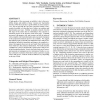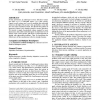26354 search results - page 107 / 5271 » How we refactor, and how we know it |
EUROCRYPT
2005
Springer
14 years 3 months ago
2005
Springer
Abstract. MD5 is one of the most widely used cryptographic hash functions nowadays. It was designed in 1992 as an improvement of MD4, and its security was widely studied since then...
HT
2004
ACM
14 years 3 months ago
2004
ACM
A high quality of free movement, or mobility, is key to the accessibility, design, and usability of many ‘common-use’ hypermedia resources (Web sites) and key to good mobility...
ACNS
2003
Springer
14 years 3 months ago
2003
Springer
Key exposures, known or inconspicuous, are a real security threat. Recovery mechanisms from such exposures are required. For digital signatures such a recovery should ideally —an...
ATAL
2003
Springer
14 years 3 months ago
2003
Springer
System performance in multi-agent resource allocation systems can often improve if individual agents reduce their activity. Agents in such systems need a way to modulate their ind...
DRM
2003
Springer
14 years 3 months ago
2003
Springer
We set out to examine whether current, DRM-based online offerings of music and movies accord with consumers’ current expectations regarding the personal use of copyrighted works...


